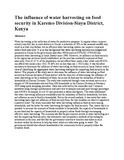| dc.description.abstract | Water harvesting is the collection of water for productive purposes. In regions where crops arc entirely rain-fed, like in most districts in Kenya, a reduction of 50% in the seasonal rainfall may result in a total crop failure, but an efficient water harvesting system can improve crops and reduce food insecurity. It is on this background that water harvesting has been encouraged and promoted in Kenya by the government and other NGOs such as KWAHO. KWAHO has promoted water harvesting in Siaya District since 1996. However, its influence on food security in the region has not been clearly established, yet the area has constantly experienced food insecurity. Over 62.31 % of the population can not afford three meals a day, while only 69.02% can afford two meals a day. Over 78.36% live on less than one 1 USD a day.
It was therefore necessary to determine the influence of water harvesting on food security in Siaya District with a view of identifying the appropriate water harvesting strategies for improving food security in the district. The purpose of the study was to determine the influence of water harvesting on food security in Karemo division of Siaya district with the objective of determining the influence of water harvesting on the availability of food, the access to food and the utilization of food by households in
Karemo Division.
The study was conducted through cross sectional survey on a sample of 100 households selected from 638 households in the Karemo Division in February 2010 using quota sampling procedure. Data was collected by the researcher and 5 research assistants using through questionnaire and interview techniques and analyzed through parentages and ANOVA techniques at a of .05 and presented in tables and figures. The study established that water harvesting influences availability and the utilization of food by households, but does not influence access to food by households. But on the overall analysis, it was noted that water harvesting had a high net influence of food security from the two variables on which it registered a positive result.
The study concludes that water harvesting influences food security among households, and the better the water harvesting the higher the food security. This. meant that it is possible to increase the amounts of foods available to households, the capacity of households to access food and the capacity of households to properly utilize foods through encouraging effective water harvesting.
The recommends that the government invests in water harvesting as a tool for improving food security; that alternative and compulsory methods of harvesting be introduced in the area; and that that the government constructs trenches and dykes in each location within the division to help tap water which are otherwise going to waste. The government should also educate households at the community levels to properly utilize the available foods. | en_US |

